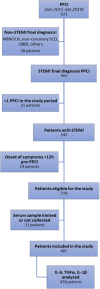Inflammatory and neutrophil extracellular trap markers to predict cardiac events after ST-segment elevation myocardial infarction
- PMID: 40168324
- PMCID: PMC11960995
- DOI: 10.1371/journal.pone.0319759
Inflammatory and neutrophil extracellular trap markers to predict cardiac events after ST-segment elevation myocardial infarction
Abstract
Background and aims: Inflammation plays a pivotal role in the pathophysiology of ST-elevation myocardial infarction (STEMI). This involves neutrophil activation and the local release of pro-inflammatory mediators. The formation of neutrophil extracellular traps (NETs) in coronary thrombosis has been linked to poor short-term prognosis following STEMI, but the usefulness of specific circulating NET components as prognostic markers is unclear. We aimed to evaluate the NET-specific marker nucleosomal citrullinated histone H3 (H3Cit-DNA) and other classical inflammatory markers to predict adverse events after STEMI.
Methods: This is a single-center retrospective cohort study of patients with STEMI undergoing primary percutaneous coronary intervention (PCI) from 2015 to 2019. We analyzed the association between serum H3Cit-DNA levels, double-stranded DNA, and classical inflammatory markers -such us interleukin (IL) 6 and 1β, TNF-α, and C-reactive protein (CRP)- on admission and the occurrence of major cardiovascular events (MACE), including death, reinfarction, urgent revascularization, or heart failure, after STEMI.
Results: A total of 487 patients were studied, of which 380 were men [78%]; mean [SD] age of patients was 63 [13] years, and median [95%CI] follow-up was 5.4 [5.2-5.5] years. Median [IQR] H3Cit level was 179.30 [105.30-281.47] ng/ml. No relevant association was found between H3Cit-DNA levels and 30-day mortality (OR, 1.03 [95%CI, 0.71-1.50], p = 0.861) or MACE (0.98 [0.72-1.32], p = 0.879), Killip class (0.95 [0.74-1.21], p = 0.664), or left ventricular ejection fraction (ref.cat. > 50%; < 35%, RRR 1.01 [95%CI, 0.74-1.38], p = 0.952; 35-50%, 1.26 [1.07-1.48], p = 0.005]. Adding CRP and IL-6 levels as covariates to a model based on classical risk factors significantly improved the prediction of MACE at 30 days after STEMI (IDI 0.13; NRI 0.32, p < 0.05).
Conclusions: Circulating levels of the NET marker H3Cit-DNA at the time of primary PCI were not predictive of cardiovascular events following STEMI. In contrast, the classical inflammatory markers CRP and interleukin-6 significantly enhanced the discriminative capacity of a clinical 30-day risk prediction model. These findings suggest that measuring circulating NET-specific markers may have limited utility in assessing the inflammatory state during the early stages of STEMI.
Copyright: © 2025 Blasco et al. This is an open access article distributed under the terms of the Creative Commons Attribution License, which permits unrestricted use, distribution, and reproduction in any medium, provided the original author and source are credited.
Conflict of interest statement
The authors have declared that no competing interests exist.
Figures


References
-
- Maier W, Altwegg LA, Corti R, Gay S, Hersberger M, Maly FE, et al.. Inflammatory markers at the site of ruptured plaque in acute myocardial infarction: locally increased interleukin-6 and serum amyloid A but decreased C-reactive protein. Circulation. 2005;111(11):1355–61. doi: 10.1161/01.CIR.0000158479.58589.0A - DOI - PubMed
MeSH terms
Substances
LinkOut - more resources
Full Text Sources
Research Materials
Miscellaneous

